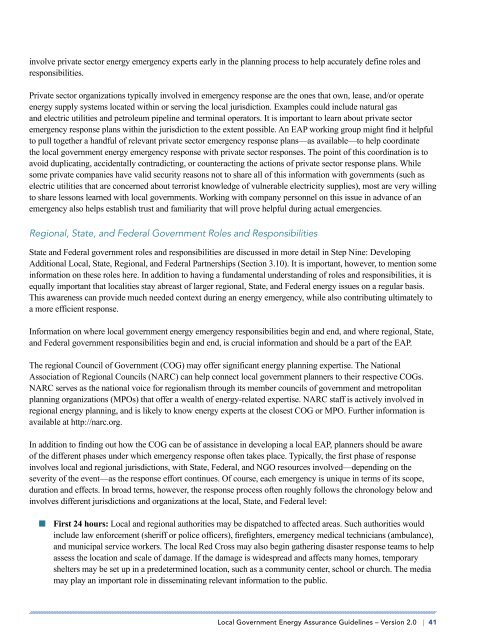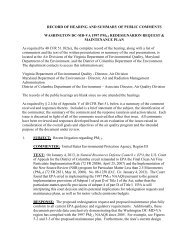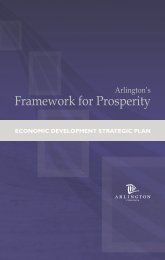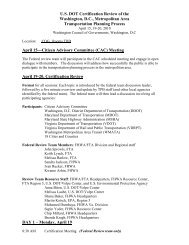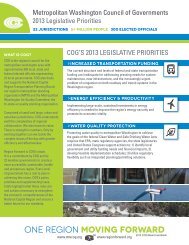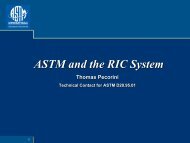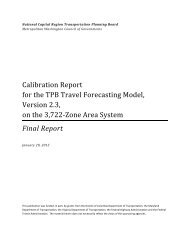PTI Local Government Energy Assurance Guidelines - Metropolitan ...
PTI Local Government Energy Assurance Guidelines - Metropolitan ...
PTI Local Government Energy Assurance Guidelines - Metropolitan ...
Create successful ePaper yourself
Turn your PDF publications into a flip-book with our unique Google optimized e-Paper software.
involve private sector energy emergency experts early in the planning process to help accurately define roles and<br />
responsibilities.<br />
Private sector organizations typically involved in emergency response are the ones that own, lease, and/or operate<br />
energy supply systems located within or serving the local jurisdiction. Examples could include natural gas<br />
and electric utilities and petroleum pipeline and terminal operators. It is important to learn about private sector<br />
emergency response plans within the jurisdiction to the extent possible. An EAP working group might find it helpful<br />
to pull together a handful of relevant private sector emergency response plans—as available—to help coordinate<br />
the local government energy emergency response with private sector responses. The point of this coordination is to<br />
avoid duplicating, accidentally contradicting, or counteracting the actions of private sector response plans. While<br />
some private companies have valid security reasons not to share all of this information with governments (such as<br />
electric utilities that are concerned about terrorist knowledge of vulnerable electricity supplies), most are very willing<br />
to share lessons learned with local governments. Working with company personnel on this issue in advance of an<br />
emergency also helps establish trust and familiarity that will prove helpful during actual emergencies.<br />
Regional, State, and Federal <strong>Government</strong> Roles and Responsibilities<br />
State and Federal government roles and responsibilities are discussed in more detail in Step Nine: Developing<br />
Additional <strong>Local</strong>, State, Regional, and Federal Partnerships (Section 3.10). It is important, however, to mention some<br />
information on these roles here. In addition to having a fundamental understanding of roles and responsibilities, it is<br />
equally important that localities stay abreast of larger regional, State, and Federal energy issues on a regular basis.<br />
This awareness can provide much needed context during an energy emergency, while also contributing ultimately to<br />
a more efficient response.<br />
Information on where local government energy emergency responsibilities begin and end, and where regional, State,<br />
and Federal government responsibilities begin and end, is crucial information and should be a part of the EAP.<br />
The regional Council of <strong>Government</strong> (COG) may offer significant energy planning expertise. The National<br />
Association of Regional Councils (NARC) can help connect local government planners to their respective COGs.<br />
NARC serves as the national voice for regionalism through its member councils of government and metropolitan<br />
planning organizations (MPOs) that offer a wealth of energy-related expertise. NARC staff is actively involved in<br />
regional energy planning, and is likely to know energy experts at the closest COG or MPO. Further information is<br />
available at http://narc.org.<br />
In addition to finding out how the COG can be of assistance in developing a local EAP, planners should be aware<br />
of the different phases under which emergency response often takes place. Typically, the first phase of response<br />
involves local and regional jurisdictions, with State, Federal, and NGO resources involved—depending on the<br />
severity of the event—as the response effort continues. Of course, each emergency is unique in terms of its scope,<br />
duration and effects. In broad terms, however, the response process often roughly follows the chronology below and<br />
involves different jurisdictions and organizations at the local, State, and Federal level:<br />
■ ■ First 24 hours: <strong>Local</strong> and regional authorities may be dispatched to affected areas. Such authorities would<br />
include law enforcement (sheriff or police officers), firefighters, emergency medical technicians (ambulance),<br />
and municipal service workers. The local Red Cross may also begin gathering disaster response teams to help<br />
assess the location and scale of damage. If the damage is widespread and affects many homes, temporary<br />
shelters may be set up in a predetermined location, such as a community center, school or church. The media<br />
may play an important role in disseminating relevant information to the public.<br />
<strong>Local</strong> <strong>Government</strong> <strong>Energy</strong> <strong>Assurance</strong> <strong>Guidelines</strong> – Version 2.0 | 41


